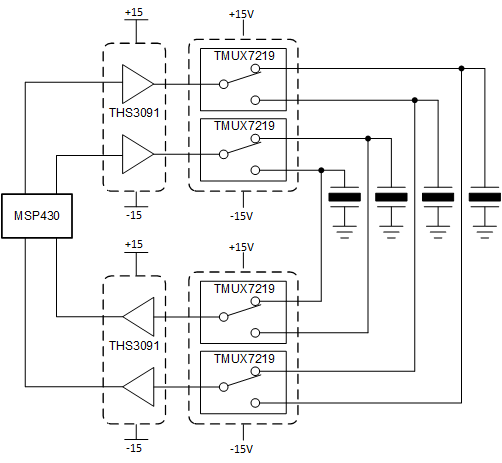SCDS407E November 2020 – August 2022 TMUX7219
PRODUCTION DATA
- 1 Features
- 2 Applications
- 3 Description
- 4 Revision History
- 5 Pin Configuration and Functions
-
6 Specifications
- 6.1 Absolute Maximum Ratings
- 6.2 ESD Ratings
- 6.3 Thermal Information
- 6.4 Recommended Operating Conditions
- 6.5 Source or Drain Continuous Current
- 6.6 ±15 V Dual Supply: Electrical Characteristics
- 6.7 ±15 V Dual Supply: Switching Characteristics
- 6.8 ±20 V Dual Supply: Electrical Characteristics
- 6.9 ±20 V Dual Supply: Switching Characteristics
- 6.10 44 V Single Supply: Electrical Characteristics
- 6.11 44 V Single Supply: Switching Characteristics
- 6.12 12 V Single Supply: Electrical Characteristics
- 6.13 12 V Single Supply: Switching Characteristics
- 6.14 Typical Characteristics
-
7 Parameter Measurement Information
- 7.1 On-Resistance
- 7.2 Off-Leakage Current
- 7.3 On-Leakage Current
- 7.4 Transition Time
- 7.5 tON(EN) and tOFF(EN)
- 7.6 Break-Before-Make
- 7.7 tON (VDD) Time
- 7.8 Propagation Delay
- 7.9 Charge Injection
- 7.10 Off Isolation
- 7.11 Crosstalk
- 7.12 Bandwidth
- 7.13 THD + Noise
- 7.14 Power Supply Rejection Ratio (PSRR)
- 8 Detailed Description
- 9 Application and Implementation
- 10Power Supply Recommendations
- 11Layout
- 12Device and Documentation Support
- 13Mechanical, Packaging, and Orderable Information
Package Options
Mechanical Data (Package|Pins)
Thermal pad, mechanical data (Package|Pins)
- DGK|8
Orderable Information
9.2.2 Ultrasonic Sensing Gas Meter
Another application of the TMUX7219 is in the ultrasonic sensing gas meter.
Ultrasonic sensing of gas flow uses the time of flight (ToF) of an ultrasonic wave and
its dependency and behavior in the medium using two transducer pairs for upstream and
downstream paths. Figure 9-3 shows a circuit example utilizing the MSP430FR6043 MCU, high voltage
low distortion operational amplifiers (THS3091), along with TMUX7219, 2:1 precision switches. The TMUX7219 are needed to select the Rx and Tx path of the transducer. The TMUX7219 offers low on-state resistance and causes a
very low signal distortion. The break-before-make feature allows transferring of a
signal from one port to another, with a minimal signal distortion. This device also
offers a low charge injection which makes this device suitable for high-performance
audio and data acquisition systems.
 Figure 9-3 Ultrasonic Sensing Gas Meter
System
Figure 9-3 Ultrasonic Sensing Gas Meter
System
 Figure 9-3 Ultrasonic Sensing Gas Meter
System
Figure 9-3 Ultrasonic Sensing Gas Meter
System